MARIANI’S
Virtual
Gourmet
February 7,
2016
NEWSLETTER
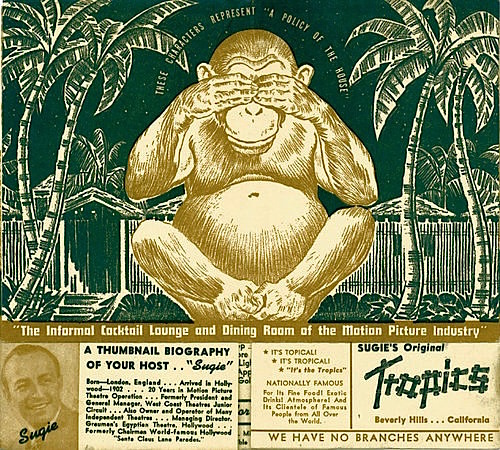
Menu
from Sugie's Original Tropics, Beverly Hills, CA, 1942
IN THIS ISSUE
DINING OUT IN RALEIGH, NC
Part One
By John Mariani
NEW YORK CORNER
BLUE FIN
By John Mariani
NOTES FROM THE WINE CELLAR
THE WINES OF LOUIS M. MARTINI
By Brian Freedman
❖❖❖
DINING OUT IN RALEIGH, NC
Part One
By John Mariani
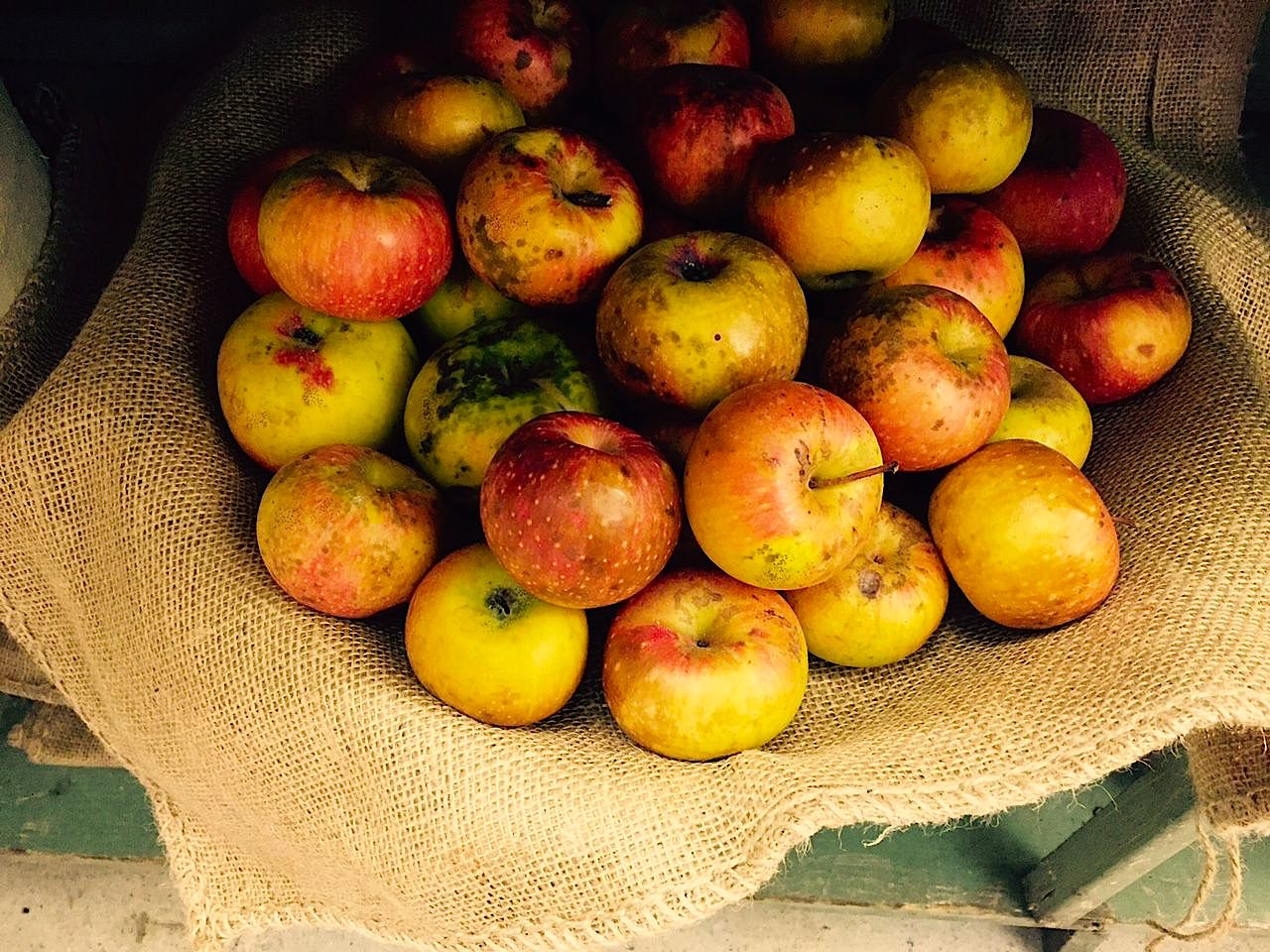
Apples at Standard Foods, Raleigh. Photo by John Mariani
It is a very big mistake to think that any major
city in America, even New Orleans, has been immune
to global and ethnic culinary influences. So,
while the local, home-style food of a city might
quite reasonably be its primary appeal—Tex-Mex in
Houston, chowders in Boston, and cheesesteaks in
Philly—visitors would miss a great deal by not
being open to the variety of foods and restaurants
now to be found in a Southern city like Raleigh,
North Carolina.
 THE UMSTEAD
HOTEL
THE UMSTEAD
HOTEL
AND SPA
100 Woodland Pond
Drive, Cary, NC
919-447-4000
theumstead.com
Next
week, I’ll write about some of those down-home
options, but this week I’d like to focus on the more
contemporary food scene, beginning with a restaurant
of daunting excellence in a resort, The Umstead Hotel
and Spa in Cary, NC, that ranks with the
finest in America.
As well it should: Spread over 12 acres of
landscaped woods and river, the resort was built by
local philanthropist and art collector Ann Goodnight, whose
husband, Jim, made a fortune as founder of analytics
software giant SAS.
As you drive onto the Umstead’s
property, you immediately recognize that not one
square inch of the land or hotel was neglected, from
the extraordinary artwork Mrs. Goodnight installed
throughout the hotel to the 14,000-square-foot
state-of-the-art Spa.
The exterior limestone, from quarries in
Texas, blends into the surroundings,  and the beautiful interior
woodwork is of the highest quality, as is every
stitch of linen, every bathroom amenity, and every
business traveler’s need in the spacious rooms that
look out over the greenery and flowing water.
and the beautiful interior
woodwork is of the highest quality, as is every
stitch of linen, every bathroom amenity, and every
business traveler’s need in the spacious rooms that
look out over the greenery and flowing water.
Artist Dale Chihuly did a glass
sculpture (above)
for the hotel named Ardea,
meaning a
heron, which echoes the name of the resort’s elegant
Herons
restaurant. Executive
Chef Steven Greene and Chef de Cuisine Spencer
Thomson, both previously from Greenville, SC, have
worked hard to earn just about every top hospitality
award from the media, and I happily chime in with
more kudos.
The dining room has perfect
romantic lighting, genial table spacing, a civilized
sound level and a sophisticated service staff that
would easily fit in just as well in New 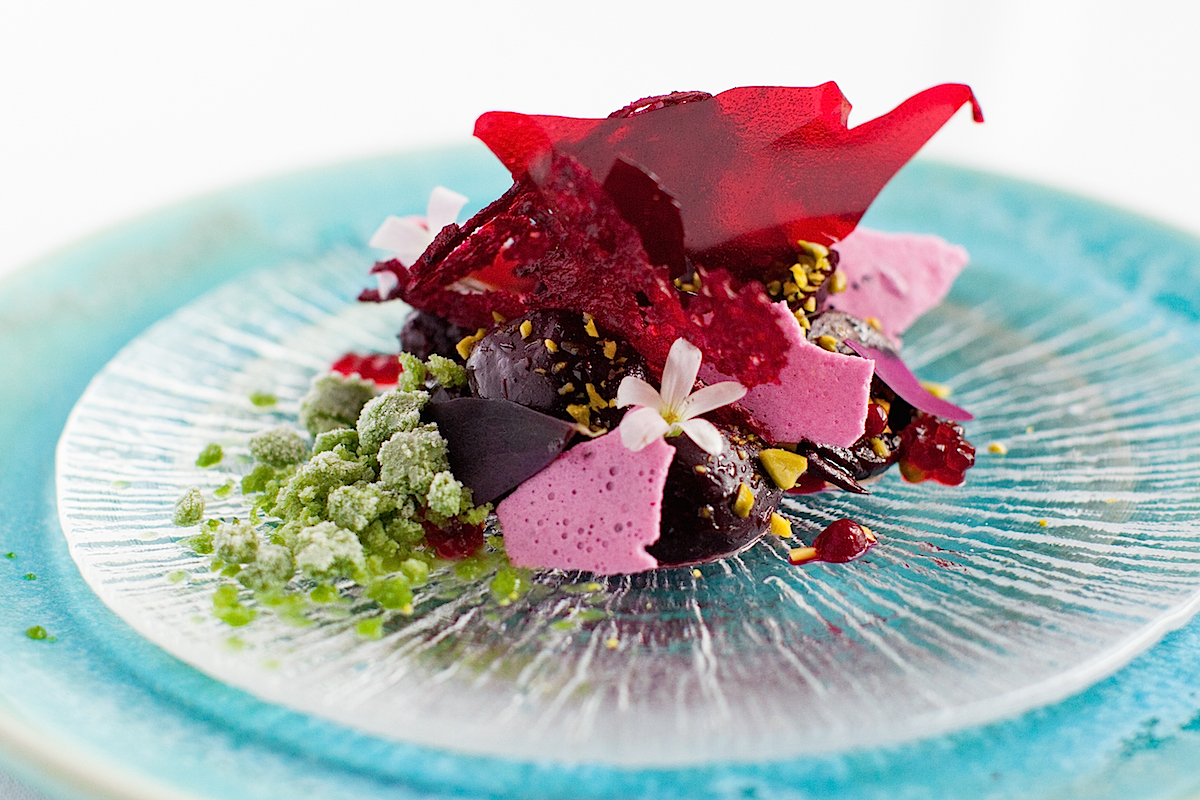 York or London. My wife
and I enjoyed two different tasting menus and, while
I mentioned to Chef Greene that some of his dishes
were in need of editing—canapés on billowing dry
ice, too many ingredients on a plate of scallops
with cauliflower custard, carbonized bamboo, tapioca
and black rice—the overall quality was on a par with
the best in America right now, beginning with
various textures of beets with pistachio, a touch of
trout roe, purple sorrel and goat’s milk. White
chocolate was a surprisingly good addition to a dish
of chestnuts with quince, bacon, brown butter and
crème fraîche, and sea bass was impeccably cooked,
served with carrots, vaouvan-spiced curry, tender
Littleneck clams and citrus-scented kasha.
York or London. My wife
and I enjoyed two different tasting menus and, while
I mentioned to Chef Greene that some of his dishes
were in need of editing—canapés on billowing dry
ice, too many ingredients on a plate of scallops
with cauliflower custard, carbonized bamboo, tapioca
and black rice—the overall quality was on a par with
the best in America right now, beginning with
various textures of beets with pistachio, a touch of
trout roe, purple sorrel and goat’s milk. White
chocolate was a surprisingly good addition to a dish
of chestnuts with quince, bacon, brown butter and
crème fraîche, and sea bass was impeccably cooked,
served with carrots, vaouvan-spiced curry, tender
Littleneck clams and citrus-scented kasha.
These
and many other courses were matched with excellent
selections of wines, from a Viognier with the
chestnut dish to a Spätburgunder with the sea bass. Desserts
were showy but superbly rendered, including a crèmeux of
milk chocolate, kalamansi,
green tea chiffon and cocoa pearls, as were the
end-of-the-meal mignardises. Herons matches everything
else of quality at the Umstead but stands as a
culinary beacon in the entire region, a restaurant
of great generosity and elegant proof of fine
dining’s enduring pleasures.
Herons is
open for breakfast, lunch and dinner daily.
STANDARD FOODS
205 East Franklin Street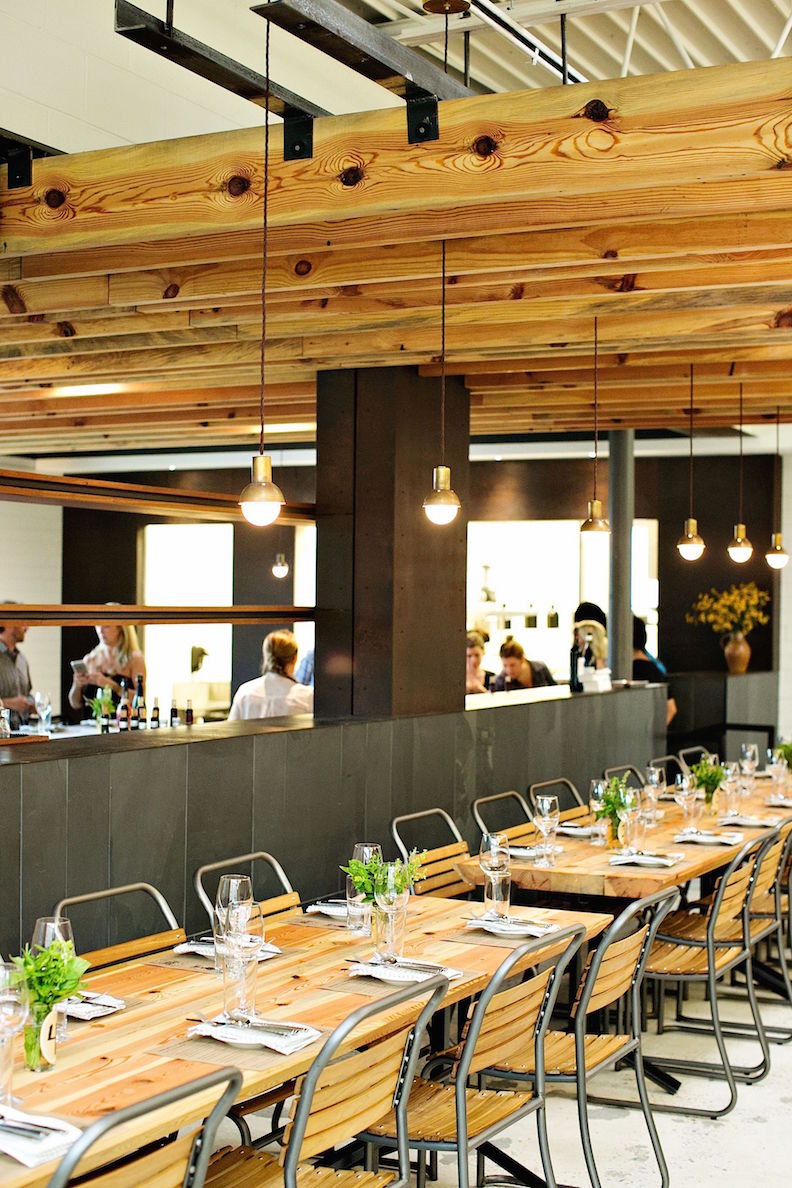
919-307-4652
standard-foods.com
Standard
Foods pretends to no such luxury as The Umstead but
happily represents the seriousness of modern cooking
under an impressive chef who relies on the quality
of local ingredients, which are also sold right on
the premises, including a butcher shop: baskets of
local fruits and an array of Southern products from
un-homogenized milk and cheeses to burlap bags of
stoneground grits and honey from a local apiary.
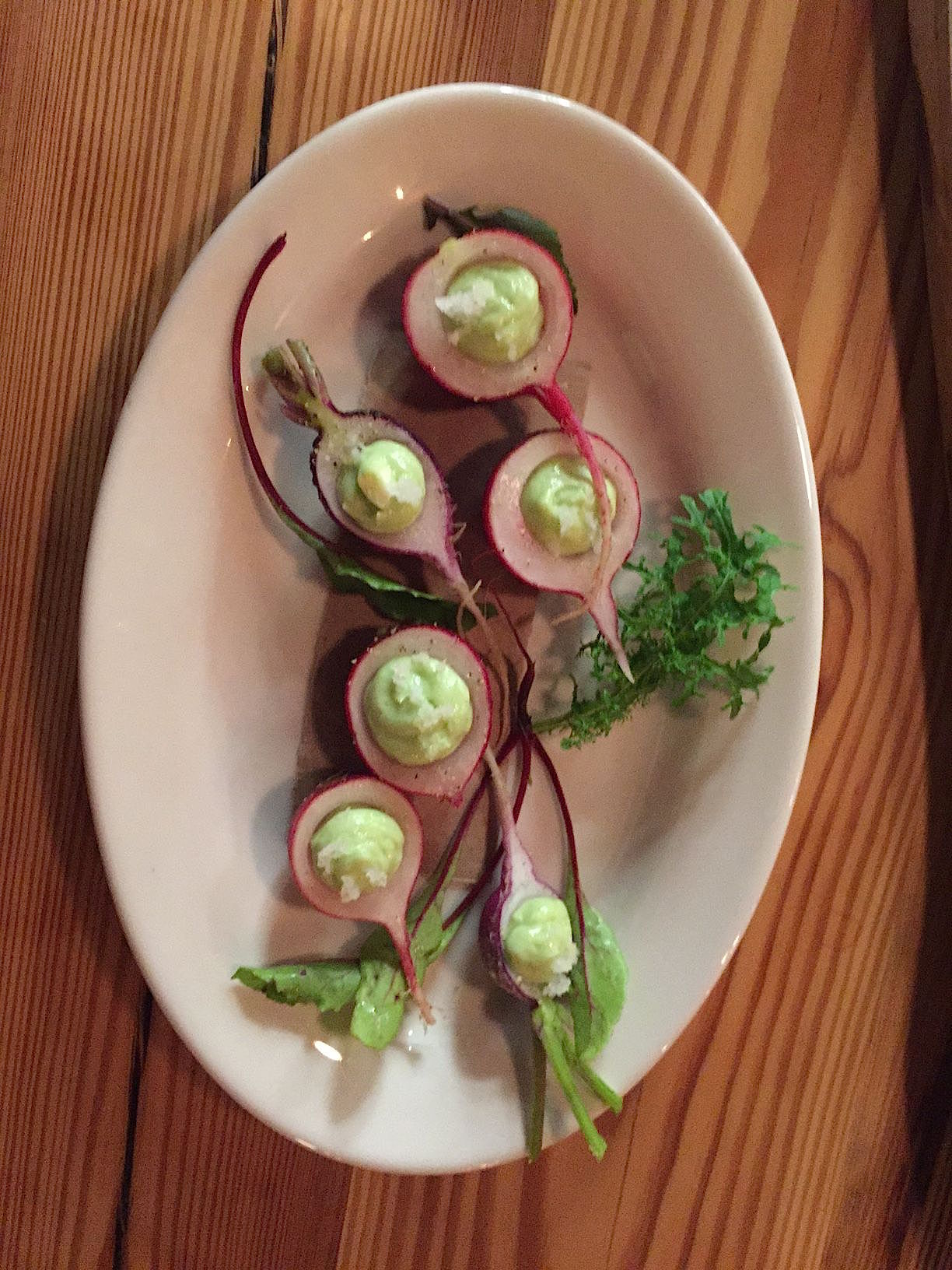 The premises
are bisected, with the dining room (right) to the
left. When I was there the noise level was
deafening, but I’m told that some re-designing has
ameliorated this drawback. It’s a very casual place,
lots of wood on ceilings and tables, with a cement
floor and an open kitchen to the rear. Best
thing to do is order family style. Chef-owner Scott
Crawford, former chef at Herons and before that at
The Cloisters in Sea Island, GA, along
with Chef de Cuisine Bret Edlund present such
exquisitely beautiful dishes it would be a crime not
to share them with your friends, fork by fork, spoon
by spoon.
The premises
are bisected, with the dining room (right) to the
left. When I was there the noise level was
deafening, but I’m told that some re-designing has
ameliorated this drawback. It’s a very casual place,
lots of wood on ceilings and tables, with a cement
floor and an open kitchen to the rear. Best
thing to do is order family style. Chef-owner Scott
Crawford, former chef at Herons and before that at
The Cloisters in Sea Island, GA, along
with Chef de Cuisine Bret Edlund present such
exquisitely beautiful dishes it would be a crime not
to share them with your friends, fork by fork, spoon
by spoon.
Photo by
Jessica Crawford
Menus
change depending on season and availability, but I
hope they will always serve the savory-sweet apple
soup (right)
with smoked brown butter, peanuts and a sprinkling
of rosemary ($19); a dish of rabbit and light
dumplings with sweet potato, green apple and a tinge
of tarragon ($14) sums up what modern Southern
cuisine is all about. You can order a butcher’s
board of charcuterie ($18), complete with housemade
lardo, and
don’t fail to get the Parmesan grits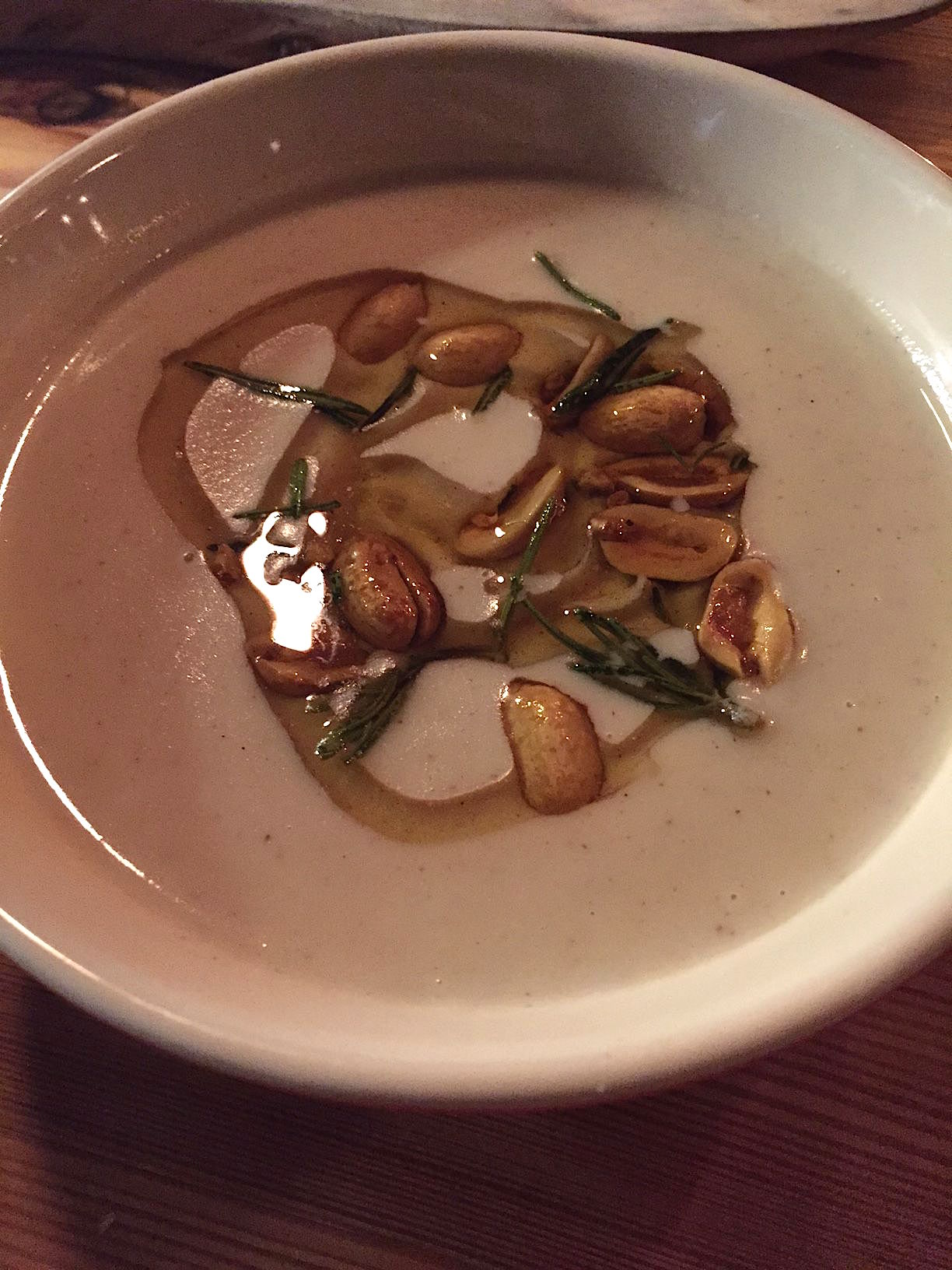 with wild mushrooms,
squash and hazelnuts ($20), a large plate to share.
with wild mushrooms,
squash and hazelnuts ($20), a large plate to share.
Flavors of fennel, radish and a
sorrel vinaigrette enhanced fine quality swordfish
($24), and of course there’s good pork here, with
white beans, sausage and apple mustard ($26). I’m
afraid the grass-fed beef just doesn’t make for fat-rich
eating, though it’s helped in the dining room by
smoked onion, sunchoke tots and marrow butter ($26).
We loved the caramel rum cake
with goat’s cheese and crème fraîche sherbet ($10),
as well as the chocolate brioche with pecan butter,
hot chocolate and soft cream ($12), one of those
desserts never to be improved upon.
Standard Foods’ wine list is
notable for its selectivity and how the bottlings
match Crawford’s cooking: hearty, meaty, with good
acids, overseen by consultant Fred Dexheimer.
This is Raleigh's hot spot right
now, jammed from Day One, and for all the right
reasons of good honest food, wine, and conviviality.
Standard
Foods is open for lunch and dinner Tues.-Sat.
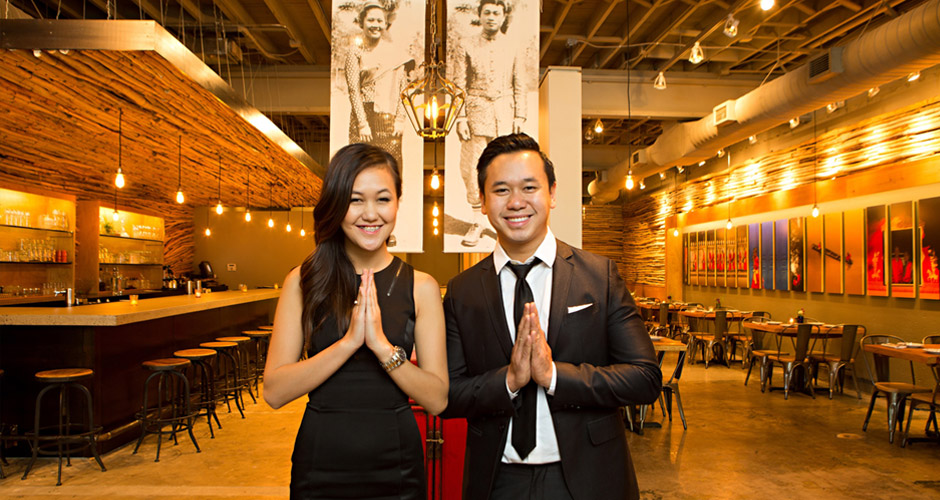
BIDA MANDA
222 South Blount Street
919-829-9999
bidamanda.com
Bida
Manda is yet another facet of contemporary dining in
Raleigh, and yet another American Dream come true. Owners Vansana
and Vanvisa Nolintha (left), along with Chef Lon
Bounsanga, are from Laos, and the name Bida Manda
describes “the Sanskrit ceremonial term for father
and mother,” in honor of the Nolinthas’ parents.
The two-room downtown eatery has
become a very popular spot in Raleigh, not least
because of the owners’ own amiable hospitality. Laotian
food is just not easy to find made this well
anywhere I know of, for there are few contenders
elsewhere in or out of the South. 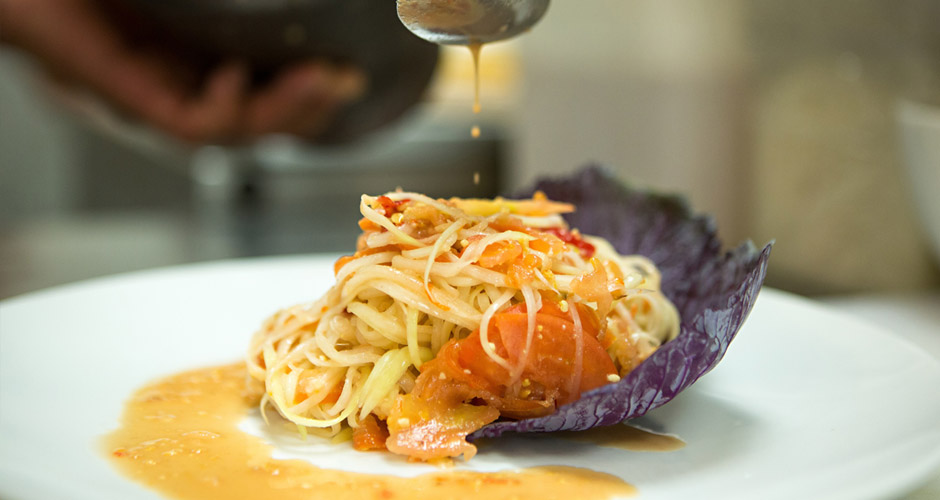
The two-sided menu offers
appetizers enough for a whole meal—crispy rice
lettuce wrap ($7.90), tom ka kai
chicken soup with galangal and coconut ($5.90), and
wonderfully crisp spring rolls filled with either
ground pork or minced vegetables ($7.90). The star
among main courses is the crispy pork belly soup
called mee ka
tee ($10.90), teeming with peanuts, vegetables
and rice noodles with tantalizing seasonings. Chicken
curry, kali
kai mae amphone ($8.90), combines generous
cuts of chicken with root vegetables and aromatic
jasmine rice, while thum mak houng is a green papaya salad
that accompanies a flatiron streak ($10.90) or
grilled chicken with lemongrass ($8.90).
To
say that one meal here will addict you to this kind
of food is an easy assertion, and I can’t imagine
not dining at Bida Manda at least once a week were I
in Raleigh, not least because the prices are so
modest but also because the excitement level is so
high, and the owners are so intent on both pleasing
and educating you in the sweetest possible way.
Bida
Manda is open for lunch Mon.-Fri., for dinner
nightly.
❖❖❖
By John Mariani
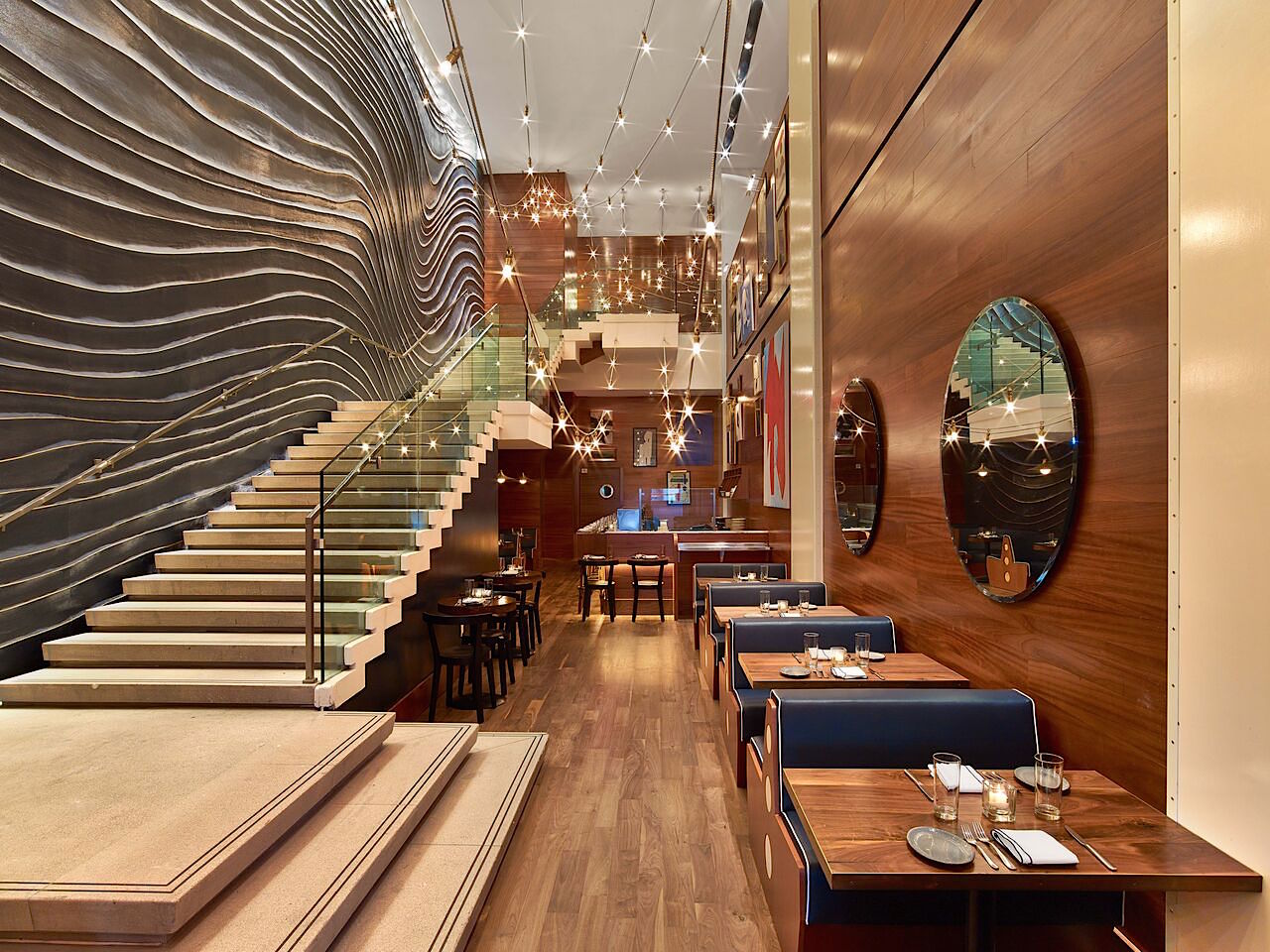 Blue
Fin
Blue
FinW Hotel
1567 Broadway (near 48th Street)
212-918-1400
bluefinnyc.com
It’s easy
enough to understand why some people might
consider the ideal restaurant to be small, owned
by the chef, and never varying or expanding. I,
too, love that ideal, but only as part of a
grander view of modern gastronomy wherein many
of the brightest concepts come from restaurant
companies with many units throughout a city, a
country, even across continents. Companies
like Union Square Hospitality, Myriad Restaurant
Group, Patina Group, and BR Guest Hospitality
run exciting, often spectacular, restaurants in
NYC, many considered to be in the top tier and
all created with enormous effort and financial
risk. (They
also tend to be seriously devoted to food-based
charities in the city.)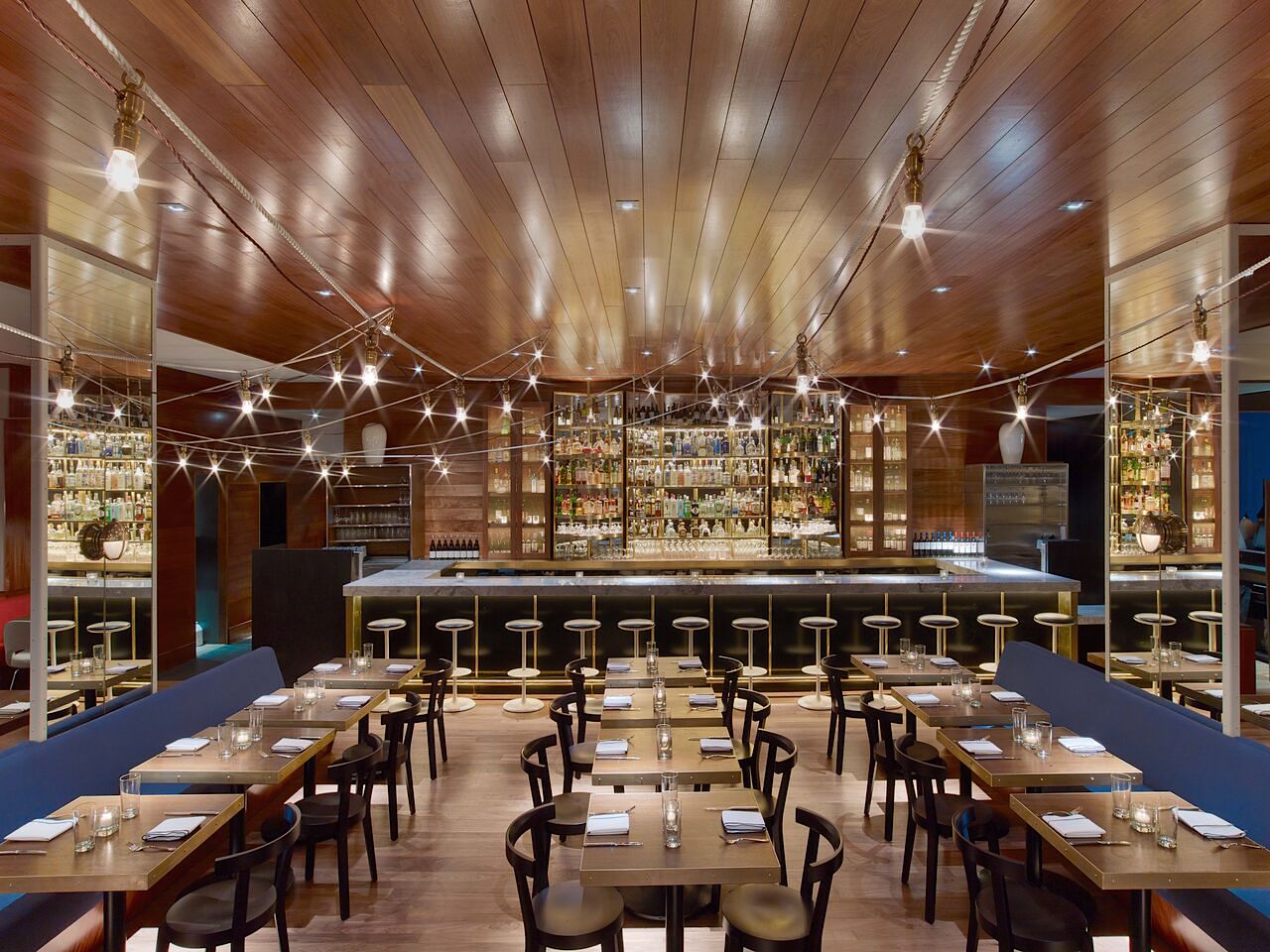
BR Guest Hospitality runs 25
restaurants, most in NYC, including the highly
popular and well-regarded Blue Water Grill, Strip
House, Atlantic Grill, and Blue Fin, newly
re-opened at the W Hotel in Times Square. With
that kind of buying clout in the market, they can
claim dibs on what’s best on a daily basis, and
that quality of ingredients shows throughout the
menu at Blue Fin.
The two-story restaurant has
been wholly re-designed and it’s a dazzler, from
the downstairs sushi bar bordered by a suspended
staircase and wavy mural to the spacious main
dining room upstairs done in wide expanses of
polished wood, mirrors, and hanging bare lights.
It’s casual but New York casual, and there seem
just as many locals dining here as tourists.
The large service staff is well
trained—they have to deal with a lot of
pre-theater pressure—and know the menu cold. The
wine and sake list, overseen by Beverage Director
Richard Breitkreutz, has breadth and depth, with a
focus on the mid-price range. There are many
choices by the glass for $11, and the “Sommelier’s
Selection” has an admirable number of bottles
under $50, though mark-ups are not so modest. A
barrel-fermented 2014 white Rioja from Bodegas
Mura runs $48 here, but only $16 at a wine store.
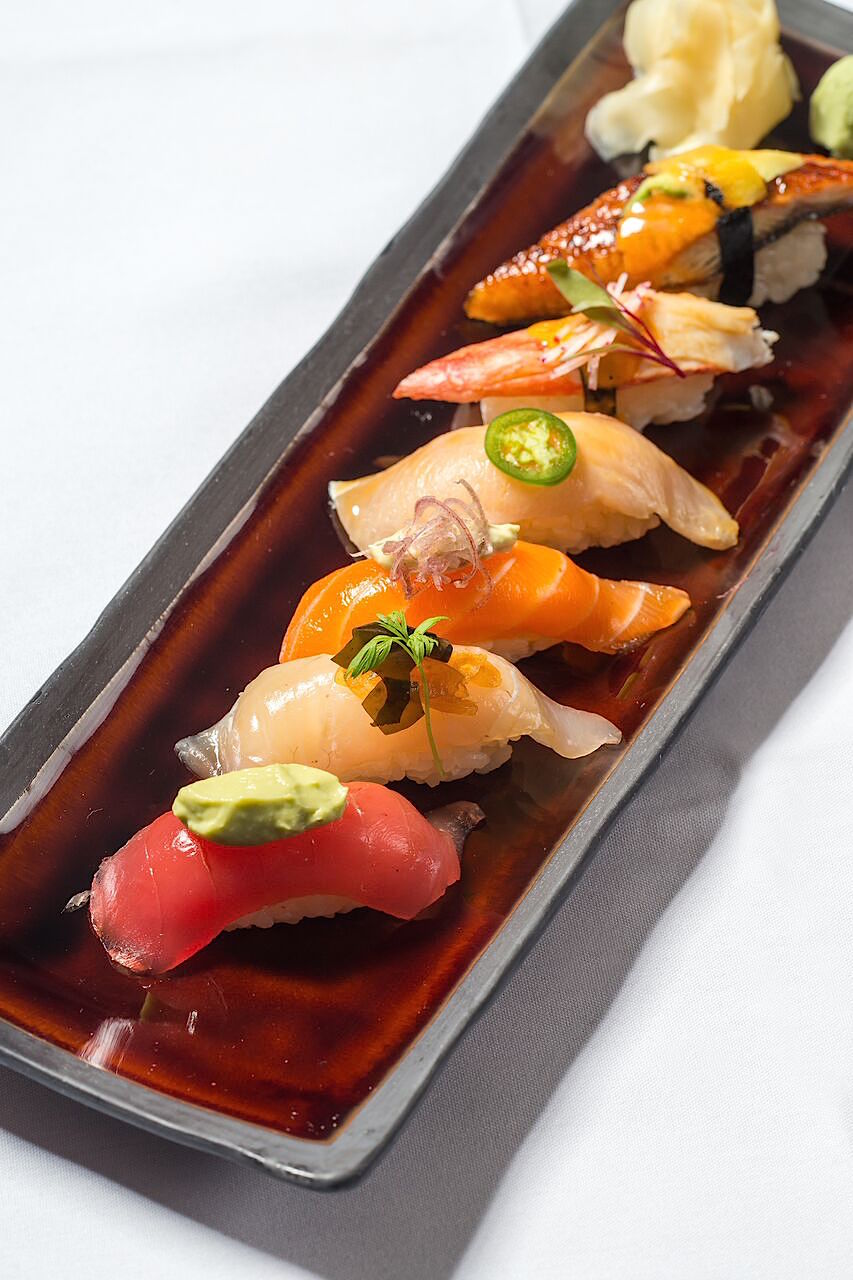 Executive
Sushi Chef Boo "Mike" Lim, formerly of the highly
regarded Sushi of Gari, and Executive Chef Juan
Carlos Ortega, now with BR Guest for two decades,
provide menus rich enough in every category
without going overboard. There are ten or so sashimi
items offered nightly, at $3 to $8 per piece, and
a six-piece sampler of dressed sushi at $28, which
I recommend as a large starter. The generous sushi
rolls ($12-$16) include the delicious “Times
Square” ($15) roll of crab, spicy hamachi, mango,
avocado, and yuzu-miso.
All the raw seafood is of pristine quality, and
the dressed varieties (left) hold more interest, like
kampachi with chile and seaweed, the tuna with
avocado and ponzu, and eel with grilled pineapple
and kojujang,
a Korean sweet fermented rice condiment like
ketchup. I also highly recommend the charred
octopus with smoked paprika, olive oil potatoes
and romesco sauce as a fine appetizer ($19).
Executive
Sushi Chef Boo "Mike" Lim, formerly of the highly
regarded Sushi of Gari, and Executive Chef Juan
Carlos Ortega, now with BR Guest for two decades,
provide menus rich enough in every category
without going overboard. There are ten or so sashimi
items offered nightly, at $3 to $8 per piece, and
a six-piece sampler of dressed sushi at $28, which
I recommend as a large starter. The generous sushi
rolls ($12-$16) include the delicious “Times
Square” ($15) roll of crab, spicy hamachi, mango,
avocado, and yuzu-miso.
All the raw seafood is of pristine quality, and
the dressed varieties (left) hold more interest, like
kampachi with chile and seaweed, the tuna with
avocado and ponzu, and eel with grilled pineapple
and kojujang,
a Korean sweet fermented rice condiment like
ketchup. I also highly recommend the charred
octopus with smoked paprika, olive oil potatoes
and romesco sauce as a fine appetizer ($19).
When you get to the entrees,
there is a shift away from Asian flavors in a
hearty dish like the lobster pot pie ($35), a kind
of American bouillabaisse with mussels, shrimp,
and a ruddy, garlic-rich rouille. There
is a simply grilled section of dishes, served with
lettuce and lemon potatoes, and the night’s catch
was superbly textured, very juicy branzino (market price). There
was plenty of sweet jumbo lump crabmeat atop a
fine red snapper ($35), along with sautéed hen of
the woods mushrooms 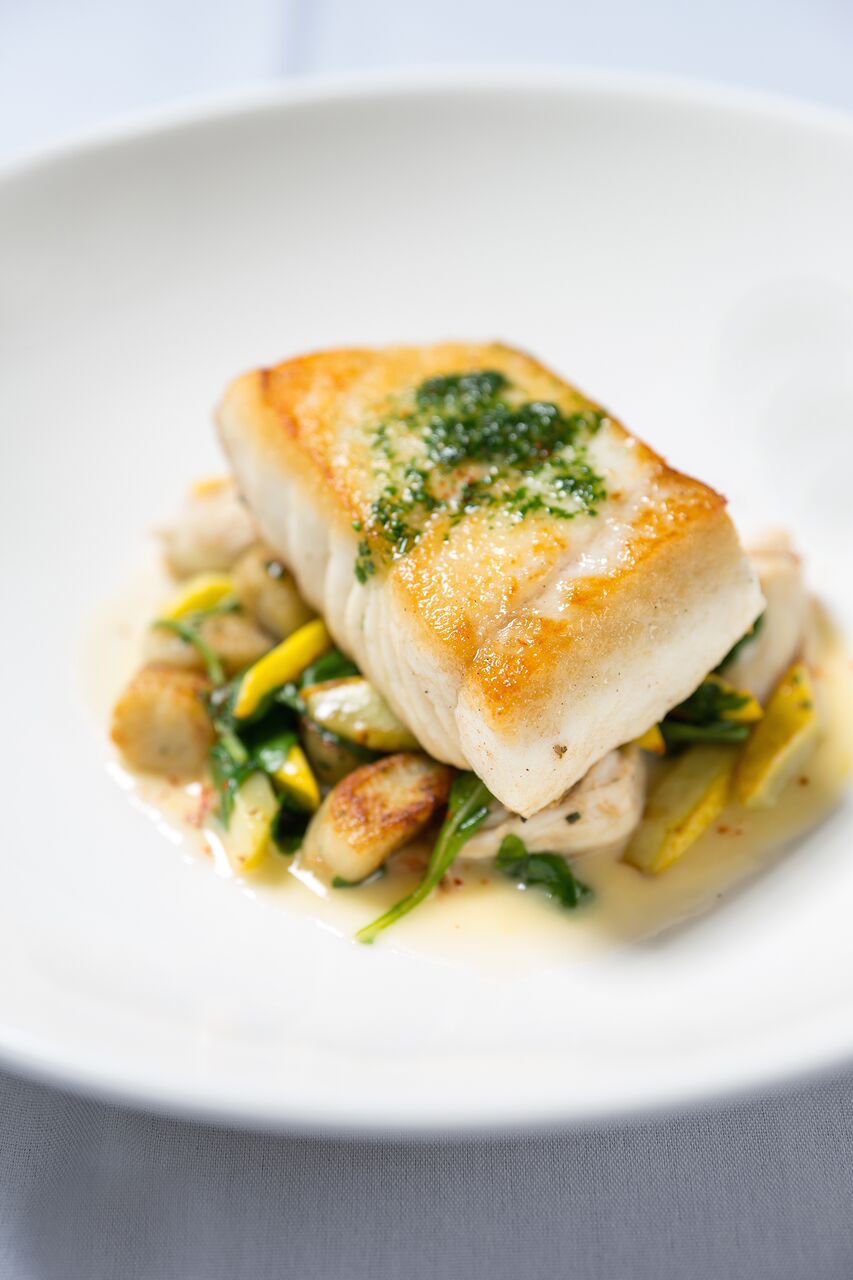 and watercress.
and watercress.
Companies like
BR Guest are aimed at big eaters and large
portions, so the warm apple crostata
with dulce
de leche and vanilla ice cream ($11), the
flourless chocolate layer cake with white
chocolate peppermint candy ice cream ($11), and
the caramel pear pecan sundae with cinnamon-spiced
ice cream ($10)—all ice creams are housemade—are
desserts easy for two to share. They
even offer “Theater Treats to Go” ($8), a box of
warm chocolate chip cookies or caramel popcorn to
stave off hunger during the third hour of “Les
Misérables” or “Hamilton.”
On a
post-snowstorm night the upstairs room at Blue Fin
was crowded by nine o’clock, but, despite all the
wooden surfaces, the decibel level did nothing to
compromise our conversation—one of those details
that must have gone into the re-design.
Blue Fin belongs right where it
is in the Times Square nexus, where, when you
leave and see the eye-popping video displays and
flashing lights of Broadway, you’ll know that your
dinner had been just as much a part of the dazzle
as the rush of the crowd and the sweet cacophony
of the Big Apple.
Blue
Fin is open for breakfast, lunch and dinner daily.
❖❖❖
THE WINES OF LOUIS M. MARTINI
By Brian Freedman
Much of my childhood was defined
by the wines
of Louis M. Martini Winery and the music of
Queen. With both of them, I had no
idea, until relatively later in life, how
seminal each of them was to their
respective industries. I won’t belabor the
importance of Freddy Mercury here,
but it’s fair to say that popular music as we
now know it would be far
different if it were not for classics like
“Bohemian Rhapsody,” “Killer Queen”
and the rest.
 The same can be said for
Louis M. Martini when
considering the wines of California, and, indeed,
the wine industry of America
as a whole. Because the trajectory of the company,
from its origins more than
eight decades ago up to the excellent current
releases, is as emblematic of the
evolution of American wine as that of any in the
nation.This past autumn, I had the opportunity to
immerse myself in Martini as part of a trip
sponsored by Gallo, Martini’s
owner. We also focused on other notable properties
in Napa and Sonoma,
including MacMurray Estate Vineyards, J Vineyards
& Winery, and William
Hill Estate Winery, which I’ll cover in detail in
a future Virtual Gourmet. Martini in
particular, however, is a fascinating
producer to start with, since, as it approaches
its 85th year, it is absolutely
as strong as ever, with tremendous expressiveness,
terroir specificity, and
value among its stable of wines, regardless of
price point. I drink them
regularly to this day.
The same can be said for
Louis M. Martini when
considering the wines of California, and, indeed,
the wine industry of America
as a whole. Because the trajectory of the company,
from its origins more than
eight decades ago up to the excellent current
releases, is as emblematic of the
evolution of American wine as that of any in the
nation.This past autumn, I had the opportunity to
immerse myself in Martini as part of a trip
sponsored by Gallo, Martini’s
owner. We also focused on other notable properties
in Napa and Sonoma,
including MacMurray Estate Vineyards, J Vineyards
& Winery, and William
Hill Estate Winery, which I’ll cover in detail in
a future Virtual Gourmet. Martini in
particular, however, is a fascinating
producer to start with, since, as it approaches
its 85th year, it is absolutely
as strong as ever, with tremendous expressiveness,
terroir specificity, and
value among its stable of wines, regardless of
price point. I drink them
regularly to this day.
They’ve had years to figure
things out. Louis
M. Martini (above,
with his son
Louis P. Martini), at twelve years old,
came with his father from Genoa to San
Francisco, and what started in 1906
as home winemaking evolved into a producer of
sacramental wine and concentrate during the dark
years of Prohibition, finally culminating in the
construction of the eponymous
winery in St. Helena in 1933. All of these changes
and growth have resulted in
a brand with significant name recognition,
ownership of one of the great
Cabernet vineyards on the planet, and a list of
wines that, vintage after
vintage, are worth seeking out. Martini has
always been synonymous with
Cabernet Sauvignon, and its Napa and Alexander
Valley bottlings are among the
most widely known. Tasting them side by side is
always a fascinating exercise,
and often throws into sharp relief the fallacy of
believing that the conditions
of a particular vintage manifest themselves in
stylistically similar
expressions from one appellation to another.
The 2012s
are a great example. The Napa Valley
Cabernet Sauvignon starts off subtly, with aromas
of baking spice, vanilla and
plum leading to a palate of boysenberry,
blackberry and mulberry, perfumed with
cedar and cut through with excellent acidity. The
Alexander Valley, by
comparison, lifts from the glass with black
cherry, cassis, blueberry and plum,
all spiced with cinnamon and clove, the flavors
anchored by a great core of
cassis framed by mineral, licorice, cedar, and
tobacco. It’s concentrated and
fresh all at once, and while both of these
bottlings will benefit from a few
years in the cellar, they are immensely enjoyable
right now.
The 2013 Sonoma County Cabernet
Sauvignon
starts off with scents of cassis, toast, and an
unexpected hint of meatiness
and bay leaf.  Rich,
well-integrated tannins frame chocolate, graphite,
blackberry and warm vanilla, the balance of sweet
fruit and structure
immediately appealing.
Rich,
well-integrated tannins frame chocolate, graphite,
blackberry and warm vanilla, the balance of sweet
fruit and structure
immediately appealing.
Going up in price and down in
production
numbers is the Lot 1 Cabernet Sauvignon, a wine
that, according to Martini, is
designed to capture “the essence of Napa Valley’s
distinctive terroir.” The
fruit comes from top sites in Napa, including
Atlas Peak (Stagecoach Vineyard),
Stags Leap, the Silverado Bench, Spring Mountain
and more. The 2012 is utterly
classic, with black currants and licorice, mineral
and chocolate on the nose
and opulent, silky flavors of chocolate,
blackberry fruit and rich cigar
tobacco. It’s delicious now, and will continue to
evolve for another decade or
more. For a point of comparison, we also tasted
the 2005 Lot 1 Cabernet
Sauvignon, which has, in the nearly 11 years since
the grapes were harvested,
turned into a gorgeously mature wine singing with
aromatically complex led
pencil, sandalwood and cedar, sweet fruit,
peppercorn, vanilla and dusty,
beautiful tannins.
Martini also crafts an
excellent Meritage, and
its 2012 Cellar No. 254 Napa Valley is a charmer:
Spicy, savory, cherry fruit
aromatics find a consistent counterpart on the
palate, with added flavors of
cocoa powder and an excellent tannic structure.
The 2012 Cellar No. 254 Petite
Sirah is also a success, a sweetly fruited,
concentrated and generous offering
of chocolate, blueberry coulis and a hint of dried
mushroom on the tongue.
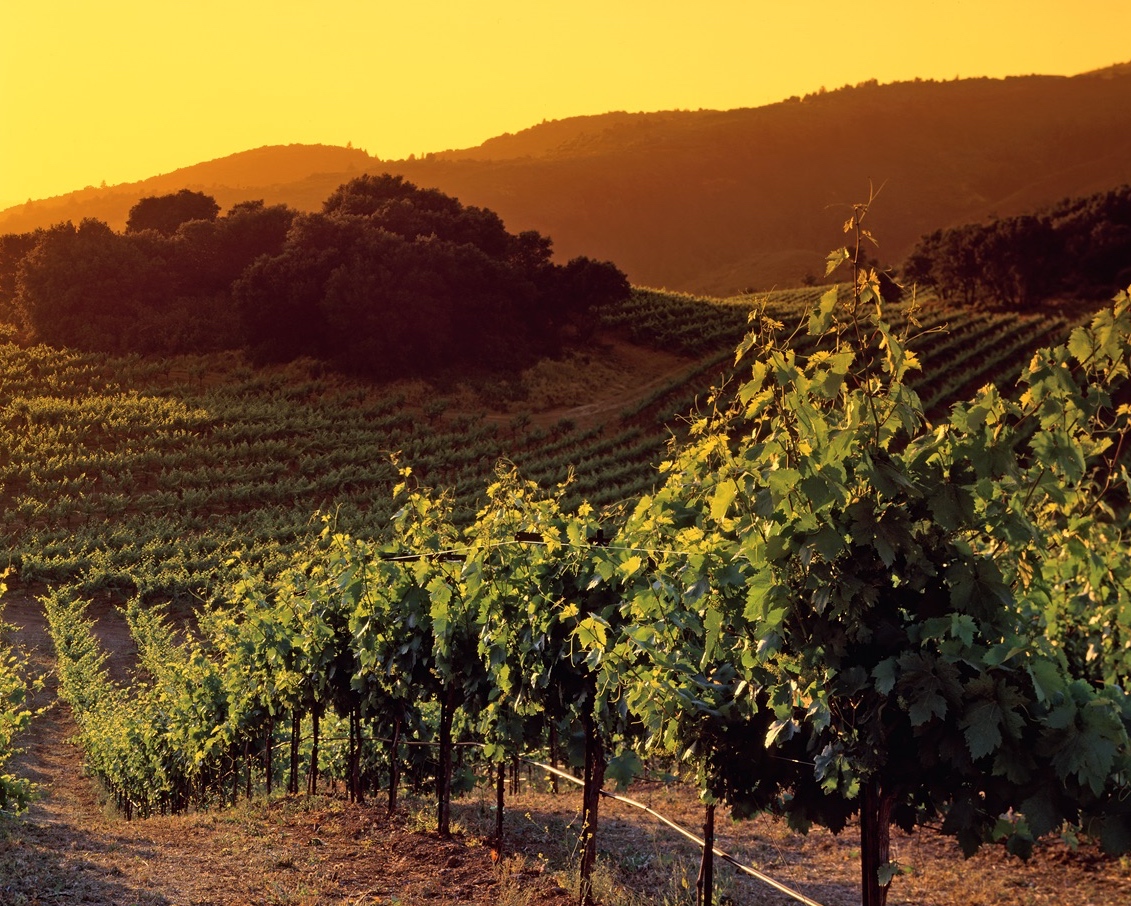 The
ostensible jewel in the Martini crown,
however, is Monte Rosso Vineyard (above and left),
so named for its Red Hill Loam soils that
Cabernet does so well in. (So, too, do other grape
varieties, including a block
of 110-year-old Semillon vines, though it’s the
Cab that garners the lion’s
share of attention.) It’s been under the ownership
of Martini since 1938, and
the results of the family’s work on it are
stunning. The 2011 Monte Rosso
Cabernet Sauvignon was fresh with lovely herb
notes of rosemary and laurel, as
well as plenty of red plums and currants. The 2010
is also quite fresh, yet here
it speaks of raspberry, mineral and a smoky note
to the rich hints of spice and
leather. Gong back another five years, the 2005 is
a perfectly balanced
bottling with brambly fruit, sage and mineral
bumping up against cherry,
baker’s chocolate and sandalwood. It’s amazingly
lithe for 11 years old, but
that seems to be a theme with these Monte Rosso
Cabernets—their ability
The
ostensible jewel in the Martini crown,
however, is Monte Rosso Vineyard (above and left),
so named for its Red Hill Loam soils that
Cabernet does so well in. (So, too, do other grape
varieties, including a block
of 110-year-old Semillon vines, though it’s the
Cab that garners the lion’s
share of attention.) It’s been under the ownership
of Martini since 1938, and
the results of the family’s work on it are
stunning. The 2011 Monte Rosso
Cabernet Sauvignon was fresh with lovely herb
notes of rosemary and laurel, as
well as plenty of red plums and currants. The 2010
is also quite fresh, yet here
it speaks of raspberry, mineral and a smoky note
to the rich hints of spice and
leather. Gong back another five years, the 2005 is
a perfectly balanced
bottling with brambly fruit, sage and mineral
bumping up against cherry,
baker’s chocolate and sandalwood. It’s amazingly
lithe for 11 years old, but
that seems to be a theme with these Monte Rosso
Cabernets—their ability to
evolve yet still remain vibrant, which is a
testament to the land itself and to
the respectful winemaking of the team.
to
evolve yet still remain vibrant, which is a
testament to the land itself and to
the respectful winemaking of the team.
Monte Rosso also is home to a
range of other
grape varieties, which are more than worth seeking
out. The 2013 Malbec is all
spicy chocolate and savoriness on the nose, with a
palate of sweet, dark cherry
fruit, kirsch-filled chocolate and mineral; and
the 2012 Gnarly Vine Zinfandel,
an old-vines bottling (some of which are older
than 125 years) of power and
structure, is downright hedonistic, with sappy
blueberry and blackberry, as
well as black peppercorn spice punching up the
velvety texture. The 2012 Monte
Rosso Mountain Red, a blend of Zinfandel, Syrah
and Petite Sirah, is
sweet-souled and giving, with dark cherry and a
wildly appealing spicy plum
note coming through the plushly textured palate.
Approaching
its centenary, then, the Louis M.
Martini Winery is very much at the top of its
game, leveraging more than eight
decades of work, its historical know-how, and
Gallo’s ability to facilitate any
and all necessary changes to allow the team there
to craft wines that speak to
the appellations from which they come and the
(often quite historically
significant) soils in which the vines are grown.
If that’s not a recipe for
continued success, then I’m not sure what would
be. Turns out my youthful wine
drinking was far more significant than I realized
back then. I certainly do
now.
❖❖❖
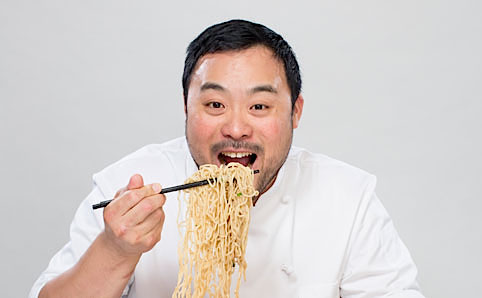
FOOD WRITING 101: WHEN IN NEED OF A GOOD QUOTE ABOUT A CLASSIC ITALIAN DISH, FIRST
ASK A KOREAN-AMERICAN CHEF
“Why do chefs love
cacio e pepe,
that ancient alchemy of sharp cheese, black pepper,
olive oil, and pasta plus cooking water? `It has all the
elements that make something taste good,’ says Dave
Chang, better known for interpretive ramen than cucina
povera. `Spice, salt, umami, dairy, and texture.
It’s in the pantheon of perfect dishes. You cannot make cacio e pepe
better.’”--Robin Raisfeld and Rob
Patronite,
"How
the Humble Cacio e Pepe Transcended Its Roots," New York Magazine
(Jan. 25, 2016).
THE WORLD NEED WAIT NO
LONGER!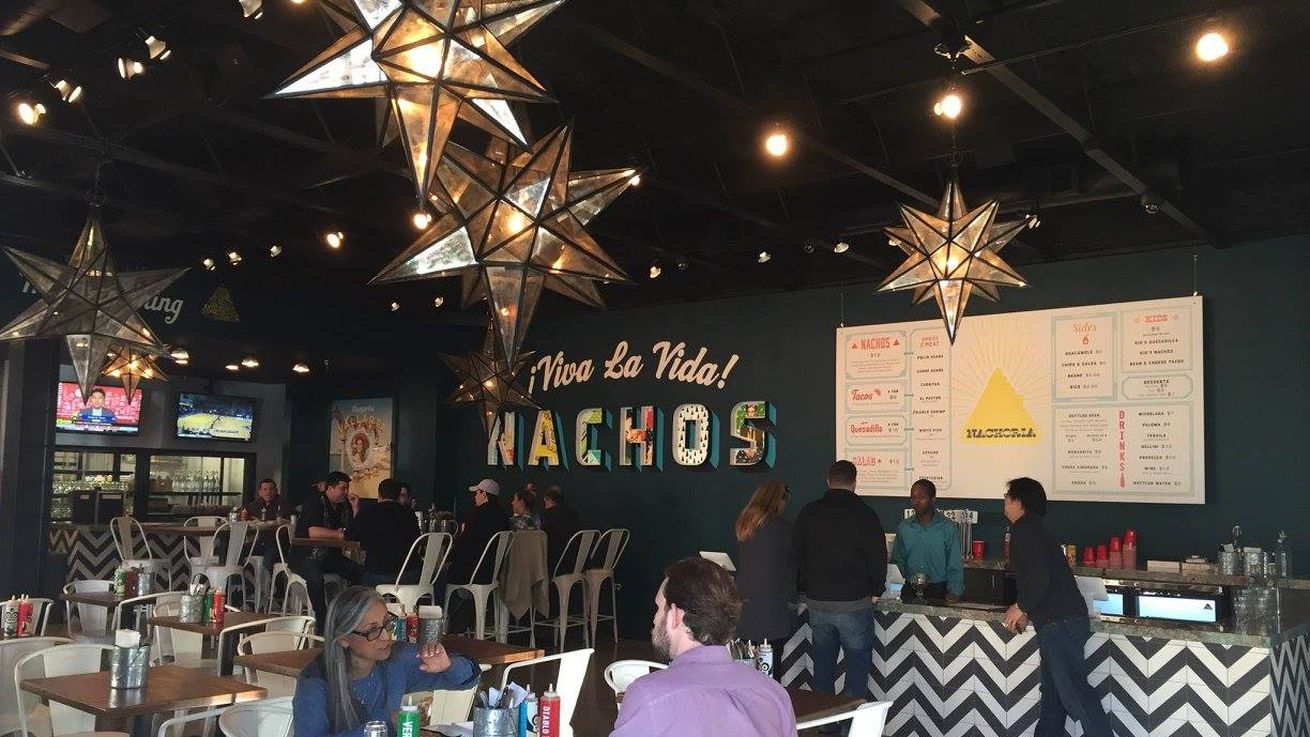
A new Bay Area restaurant called Nachoria (right) will be
devoted solely to nachos, with customers choosing a meat
(like pollo
and carne asada,
carnitas, shrimp, and even veggies or ceviche),
and topping it with a housemade cheese sauce,
fire-roasted red peppers, caramelized onions, green
onions, and queso
fresco.
Any of John Mariani's books below may be ordered from amazon.com.
 I'm proud and happy to announce that my
new book, The Hound
in Heaven (21st Century Lion Books), has just
been published through Amazon and Kindle.
I'm proud and happy to announce that my
new book, The Hound
in Heaven (21st Century Lion Books), has just
been published through Amazon and Kindle. It is a novella, and for anyone who loves dogs, Christmas, romance, inspiration, even the supernatural, I hope you'll find this to be a treasured favorite. The story concerns how, after a New England teacher, his wife and their two daughters adopt a stray puppy found in their barn in northern Maine, their lives seem full of promise. But when tragedy strikes, their wonderful dog Lazarus and the spirit of Christmas are the only things that may bring back his master back from the edge of despair.
WATCH THE VIDEO!
“What a huge surprise turn this story took! I was completely stunned! I truly enjoyed this book and its message.” – Actress Ali MacGraw
“He had me at Page One. The amount of heart, human insight, soul searching, and deft literary strength that John Mariani pours into this airtight novella is vertigo-inducing. Perhaps ‘wow’ would be the best comment.” – James Dalessandro, author of Bohemian Heart and 1906.
“John Mariani’s Hound in Heaven starts with a well-painted portrayal of an American family, along with the requisite dog. A surprise event flips the action of the novel and captures us for a voyage leading to a hopeful and heart-warming message. A page turning, one sitting read, it’s the perfect antidote for the winter and promotion of holiday celebration.” – Ann Pearlman, author of The Christmas Cookie Club and A Gift for my Sister.
“John Mariani’s concise, achingly beautiful novella pulls a literary rabbit out of a hat – a mash-up of the cosmic and the intimate, the tragic and the heart-warming – a Christmas tale for all ages, and all faiths. Read it to your children, read it to yourself… but read it. Early and often. Highly recommended.” – Jay Bonansinga, New York Times bestselling author of Pinkerton’s War, The Sinking of The Eastland, and The Walking Dead: The Road To Woodbury.
“Amazing things happen when you open your heart to an animal. The Hound in Heaven delivers a powerful story of healing that is forged in the spiritual relationship between a man and his best friend. The book brings a message of hope that can enrich our images of family, love, and loss.” – Dr. Barbara Royal, author of The Royal Treatment.
 |
The Encyclopedia of American Food and Drink by John F. Mariani (Bloomsbury USA, $35) Modesty forbids me to praise my own new book, but let me proudly say that it is an extensive revision of the 4th edition that appeared more than a decade ago, before locavores, molecular cuisine, modernist cuisine, the Food Network and so much more, now included. Word origins have been completely updated, as have per capita consumption and production stats. Most important, for the first time since publication in the 1980s, the book includes more than 100 biographies of Americans who have changed the way we cook, eat and drink -- from Fannie Farmer and Julia Child to Robert Mondavi and Thomas Keller. "This book is amazing! It has entries for everything from `abalone' to `zwieback,' plus more than 500 recipes for classic American dishes and drinks."--Devra First, The Boston Globe. "Much needed in any kitchen library."--Bon Appetit. |
"Eating Italian will never be the same after reading John Mariani's entertaining and savory gastronomical history of the cuisine of Italy and how it won over appetites worldwide. . . . This book is such a tasteful narrative that it will literally make you hungry for Italian food and arouse your appetite for gastronomical history."--Don Oldenburg, USA Today. "Italian
restaurants--some good, some glitzy--far
outnumber their French rivals. Many of
these establishments are zestfully described
in How Italian Food Conquered the World, an
entertaining and fact-filled chronicle by
food-and-wine correspondent John F.
Mariani."--Aram Bakshian Jr., Wall Street
Journal.
"Equal parts
history, sociology, gastronomy, and just
plain fun, How Italian Food Conquered the
World tells the captivating and delicious
story of the (let's face it) everybody's
favorite cuisine with clarity, verve and
more than one surprise."--Colman Andrews,
editorial director of The Daily
Meal.com. "A fantastic and fascinating
read, covering everything from the influence
of Venice's spice trade to the impact of
Italian immigrants in America and the
evolution of alta cucina. This book will
serve as a terrific resource to anyone
interested in the real story of Italian
food."--Mary Ann Esposito, host of PBS-TV's
Ciao
Italia. "John Mariani has written the
definitive history of how Italians won their
way into our hearts, minds, and
stomachs. It's a story of pleasure over
pomp and taste over technique."--Danny Meyer,
owner of NYC restaurants Union Square
Cafe, The Modern, and Maialino.
|
 |
 |
 |
 |
 |
 |
 |
 |
 Everett Potter's Travel Report:
Everett Potter's Travel Report: 
 Eating Las Vegas
JOHN CURTAS has been covering the Las Vegas
food and restaurant scene since 1995. He is
the co-author of EATING LAS VEGAS – The 50
Essential Restaurants (the fourth
edition of which will be published in early
2016), as well as the author of the Eating Las
Vegas web site: www.eatinglasvegas.
He can also be seen every Friday morning as
the “resident foodie” for Wake Up With the
Wagners on KSNV TV (NBC) Channel 3 in
Las Vegas.
Eating Las Vegas
JOHN CURTAS has been covering the Las Vegas
food and restaurant scene since 1995. He is
the co-author of EATING LAS VEGAS – The 50
Essential Restaurants (the fourth
edition of which will be published in early
2016), as well as the author of the Eating Las
Vegas web site: www.eatinglasvegas.
He can also be seen every Friday morning as
the “resident foodie” for Wake Up With the
Wagners on KSNV TV (NBC) Channel 3 in
Las Vegas.

MARIANI'S VIRTUAL GOURMET
NEWSLETTER is published weekly. Editor/Publisher: John
Mariani.
Editor: Walter Bagley. Contributing Writers: Christopher Mariani,
Robert Mariani, Misha
Mariani,
John A. Curtas, Edward Brivio, Mort Hochstein,
Andrew Chalk, Dotty Griffith and Brian Freedman. Contributing
Photographers: Galina Dargery, Bobby
Pirillo. Technical Advisor: Gerry McLoughlin.
To un-subscribe from this newsletter,click here.
© copyright John Mariani 2016

